Modeling and Simulation of Human Body Heat Transfer System Based on Air Space Values in 3D Clothing Model
Abstract
:1. Introduction
2. Materials and Methods
2.1. Multi-Node Thermoregulatory Model
2.2. The Multi-Node Thermoregulatory Model with Clothing
- i(1 to 16) represents the sixteen segments of the body,
- Qnc(i) is the direct heat transfer from the skin to the inner layer of the fabric for a clothed body segment,
- Qf(i) is the direct heat transfer from the inner layer to the outer layer of the fabric,
- Qa(i) is the direct heat flux transfer from the outer fabric layer to the environment,
- An(i), Acl(i) are the surface area of the body and clothing, respectively,
- Lnc(i) is the air gap thickness of segment I,
- Cnc(i) is the volume heat capacity of air,
- Cf is the specific heat of the fabric, and Mf is the mass of the fabric.
2.3. The Evaporative Heat Loss at the Surface of the Skin
- psk,s(i) is the saturated vapor pressure on the skin surface,
- pa(i) the ambient vapor pressure and
- he(i) is the evaporative heat transfer coefficient from the skin surface to the environment, expressed as a function of clothing vapor permeation efficiency Icl(i) by:where,
- Icl(i) is the clothing thermal insulation factor for the individual segment,
- hc(i) is the convective heat transfer coefficient, and
- LR is the Lewis ratio.
2.4. The Sensible Heat Exchange at the Surface of Skin
2.5. The Sensible Heat Loss from the Skin
- Ra is the Rayleigh number,
- Pr is the Prandtl number, H(i) is the height of the body segment I,
- ka is the thermal conductivity of air,
- g is the gravitational acceleration,
- β is the thermal coefficient of volume expansion,
- α is the thermal diffusivity, and υ is the kinematic viscosity.
- σ is the Stefan–Boltzman constant,
- en is the emissivity of skin, and
- ef is the emissivity of the fabric.
- Cp is the heat capacity at constant pressure,
- ρ the density, and
- µ is the viscosity.
3. Results and Discussion
3.1. The 3D Virtual Modeling of Cloth with 3D Ease Allowance
3.2. The Influences of Air Gap Thickness (Ease Allowance) on the Heat Transfer
4. Conclusions and Future Outlook
Author Contributions
Funding
Institutional Review Board Statement
Informed Consent Statement
Data Availability Statement
Acknowledgments
Conflicts of Interest
References
- Fanger, P.O. Analysis and Applications in Environmental Engineering; Danish Tech Press: Copenhagen, Denmark, 1970. [Google Scholar]
- Slater, K. Human Comfort; CC Thomas: Springfield, IL, USA, 1985. [Google Scholar]
- Kamalha, E.; Zeng, Y.; Mwasiagi, J.I.; Kyatuheire, S. The comfort dimension; a review of perception in clothing. J. Sens. Stud. 2013, 28, 423–444. [Google Scholar] [CrossRef]
- Fiala, D.; Lomas, K.J.; Stohrer, M. A computer model of human thermoregulation for a wide range of environmental conditions: The passive system. J. Appl. Physiol. 1999, 87, 1957–1972. [Google Scholar] [CrossRef] [PubMed]
- Fiala, D.; Lomas, K.J.; Stohrer, M. Computer prediction of human thermoregulatory and temperature responses to a wide range of environmental conditions. Int. J. Biometeorol. 2001, 45, 143–159. [Google Scholar] [CrossRef] [PubMed]
- Aboalasaad, A.; Skenderi, Z.; Kolčavová, S.B.; Khalil, A.A. Analysis of Factors Affecting Thermal Comfort Properties of Woven Compression Bandages. Autex Res. J. 2020, 20, 178–185. [Google Scholar] [CrossRef]
- Abreu, M.J.; Catarino, A.; Tama, D. Evaluating the effect of fabric type on thermal insulation properties of sports clothing. IOP Conf. Ser. Mater. Sci. Eng. 2018, 460, 12005. [Google Scholar] [CrossRef]
- Song, G.; Mandal, S.; Rossi, R.M. Effects of various factors on performance of thermal protective clothing. In Thermal Protective Clothing for Firefighters; Woodhead Publishing: Cambridge, UK, 2017; pp. 163–182. [Google Scholar]
- ASHRAE Standard 55-2020. Thermal Environmental Conditions for Human Occupancy; American Society of Heating, Refrigerating and Air-Conditioning Engineers, Inc.: Atlanta, GA, USA, 2020.
- Tanabe, S.; Zhang, H.; Arens, E.A.; Madsen, T.L.; Bauman, F. Evaluating thermal environments by using a thermal manikin with controlled skin surface temperature. ASHRAE Trans. 1994, 100, 39–48. [Google Scholar]
- Karmakar, S.; Pal, M.S.; Majumdar, D.; Majumdar, D. Application of digital human modeling and simulation for vision analysis of pilots in a jet aircraft: A case study. Work 2012, 41, 3412–3418. [Google Scholar] [CrossRef] [Green Version]
- Kalra, A. Developing FE Human Models From Medical Images; Elsevier Inc.: Amsterdam, The Netherlands, 2018; Epub ahead of print. [Google Scholar]
- Peirlinck, M.; Costabal, F.S.; Yao, J.; Guccione, J.M.; Tripathy, S.; Wang, Y.; Ozturk, D.; Segars, P.; Morrison, T.M.; Levine, S.; et al. Precision medicine in human heart modeling: Perspectives, challenges, and opportunities. Biomech. Model. Mechanobiol. 2021, 20, 803–831. [Google Scholar] [CrossRef]
- Mosleh, S.; Abtew, M.A.; Bruniaux, P.; Tartare, G.; Chen, Y. Developing an Adaptive 3D Vertebrae Model of Scoliosis Patients for applied sciences Developing an Adaptive 3D Vertebrae Model of Scoliosis Patients for Customize Garment Design. Appl. Sci. 2021, 11, 3171. [Google Scholar] [CrossRef]
- Abtew, M.A.; Bruniaux, P.; Boussu, F.; Loghin, C.; Cristian, I.; Chen, Y. Development of comfortable and well-fitted bra pattern for customized female soft body armor through 3D design process of adaptive bust on virtual mannequin. Comput. Ind. 2018, 100, 7–20. [Google Scholar] [CrossRef]
- Abtew, M.A.; Bruniaux, P.; Boussu, F.; Loghin, C.; Cristian, I.; Chen, Y.; Wang, L. Female seamless soft body armor pattern design system with innovative reverse engineering approaches. Int. J. Adv. Manuf. Technol. 2018, 98, 2271–2285. [Google Scholar] [CrossRef]
- Abtew, M.A.; Bruniaux, P.; Boussu, F.; Loghin, C.; Cristian, I.; Chen, Y.; Wang, L. A systematic pattern generation system for manufacturing customized seamless multi-layer female soft body armour through dome-formation (moulding) techniques using 3D warp interlock fabrics. J. Manuf. Syst. 2018, 49, 61–74. [Google Scholar] [CrossRef]
- Jones, B.W. Capabilities and limitations of thermal models for use in thermal comfort standards. Energy Build. 2002, 34, 653–659. [Google Scholar] [CrossRef]
- Holmér, I.; Nilsson, H.; Havenith, G.; Parsons, K. Clothing convective heat exchange-proposal for improved prediction in standards and models. Ann. Occup. Hyg. 1999, 43, 329–337. [Google Scholar] [CrossRef]
- Gagge, A.P.; Stolwijk, J.A.J.; Nishi, Y. Effective temperature scale based on a simple model of human physiological regulatory response. ASHRAE Trans. 1971, 77, 247–263. [Google Scholar]
- ISO 7730:1984 Moderate Thermal Environments—Determination of the PMV and PPD Indices and Specification of the Conditions for Thermal Comfort; ISO: Geneva, Switzerland, 1984.
- Song, G. Cothing air gap layers and thermal protective performance in single layer garment. J. Ind. Text. 2007, 36, 193–205. [Google Scholar] [CrossRef]
- Kim, I.H.; Nam, Y.J.; Han, H. A quantification of the preferred ease allowance for the men’s formal jacket patterns. Fash. Text. 2019, 6, 5. [Google Scholar] [CrossRef]
- Abtew, M.A.; Kulińska, M.; Zeng, X.; Bruniaux, P. Determinations of 3D ease allowance in a virtual environment for customized garment design using fuzzy modelling. Comput. Ind. 2021, 133, 103552. [Google Scholar] [CrossRef]
- Liu, Z.; He, Q.; Zou, F.; Ding, Y.; Xu, B. Apparel ease distribution analysis using three-dimensional motion capture. Text. Res. J. 2019, 89, 4323–4335. [Google Scholar] [CrossRef]
- Li, J.; Zhang, Z.; Wang, Y. The relationship between air gap sizes and clothing heat transfer performance. J. Text. Inst. 2013, 104, 1327–1336. [Google Scholar] [CrossRef]
- Stolwijk, J.A.J. A Mathematical Model of Physiological Temperature Regulation in Man; NASA Contractor Report; NASA: Washington, DC, USA, 1971; pp. 1–77. [Google Scholar]
- Tang, Y.; Yu, H.; Wang, Z.; Luo, M.; Li, C. Validation of the Stolwijk and Tanabe Human Thermoregulation Models for Predicting Local Skin Temperatures of Older People Under Thermal Transient Conditions. Energies 2020, 13, 6524. [Google Scholar] [CrossRef]
- Davis, P.; Cladis, F. Smith’s Anesthesia for Infants and Children, 9th ed.; Elsevier: Amsterdam, The Netherlands, 2016; Epub ahead of print. [Google Scholar]
- Tadesse, M.G.; Harpa, R.; Chen, Y.; Wang, L.; Nierstrasz, V.; Loghin, C. Assessing the comfort of functional fabrics for smart clothing using subjective evaluation. J. Ind. Text. 2018, 48, 1310–1326. [Google Scholar] [CrossRef]
- Rogale, D.; Majstorović, G.; Rogale, S.F. Comparative Analysis of the Thermal Insulation of Multi-Layer Thermal Inserts in a Protective Jacket. Materials 2020, 13, 2672. [Google Scholar] [CrossRef]
- Kuklane, K.; Toma, R. Common clothing area factor estimation equations are inaccurate for highly insulating (Icl>2 clo) and non-western loose-fitting clothing ensembles. Ind. Health 2021, 59, 107–116. [Google Scholar] [CrossRef]
- Barker, R.L.; Heniford, R.C. Factors Affecting the Thermal Insulation and Abrasion Resistance of Heat Resistant Hydro-Entangled Nonwoven Batting Materials for Use in Firefighter Turnout Suit Thermal Liner Systems. J. Eng. Fibers Fabr. 2011, 6, 1–10. [Google Scholar] [CrossRef] [Green Version]
- Zhang, Z.H.; Wang, Y.; Li, J. Model for predicting the effect of an air gap on the heat transfer of a clothed human body. Fibres Text. East. Eur. 2011, 87, 105–110. [Google Scholar]
- Chen, Y.; Fan, J.; Qian, X.; Zhang, W. Effect of Garment Fit on Thermal Insulation and Evaporative Resistance. Text. Res. J. 2004, 74, 742–748. [Google Scholar] [CrossRef]
- Havenith, G.; Kuklane, K.; Fan, J.; Lundgren, K.; Au, Y.; Loveday, D. A database of static clothing thermal insulation and vapor permeability values of non-western ensembles for use in ASHRAE Standard 55, ISO 7730, and ISO 9920: Discussion. ASHRAE Conf. Pap. 2015, 121, 197–215. [Google Scholar]
- Olesen, B.W. A New Simpler Method for Estimating the Thermal lnsulation of a Clothing Ensemble. ASHRAE Trans. 1985, 91, 478–492. [Google Scholar]
- Bouskill, L.M.; Havenith, G.; Kuklane, K.; Parsons, K.C.; Withey, W.R. Relationship Between Clothing Ventilation and Thermal Insulation. AIHA J. 2002, 63, 262–268. [Google Scholar] [CrossRef] [PubMed]
- Gagge, A.P.; Nishi, Y. Heat Exchange Between Human Skin Surface and Thermal Environment. In Comprehensive Physiology; Wiley: Hoboken, NJ, USA, 1977; pp. 69–92. [Google Scholar]
- Oguro, M.; Arens, E.; De Dear, R.; Zhang, H.; Katayama, T. Convective heat transfer coefficients and clothing insulations for parts of the clothed human body under airflow conditions. J. Arch. Plan. 2002, 67, 21–29. [Google Scholar] [CrossRef] [Green Version]
- Catton, W.R. Probable collective responses to ecological scarcity: How Violent? Sociol. Perspect. 1984, 27, 3–20. [Google Scholar] [CrossRef]
- Min, K.; Son, Y.; Kim, C.; Lee, Y.; Hong, K. Heat and moisture transfer from skin to environment through fabrics: A mathematical model. Int. J. Heat Mass Transf. 2007, 50, 5292–5304. [Google Scholar] [CrossRef]
- Kulinska, M. Digital Tools for Developing Customized Codesign Platform with Integration of Comfort and Fashion; Lille University: Lille, France, 2018. [Google Scholar]
- Murakami, S.; Kato, S.; Zeng, J. Combined simulation of airflow, radiation and moisture transport for heat release from a human body. Build. Environ. 2000, 35, 489–500. [Google Scholar] [CrossRef]
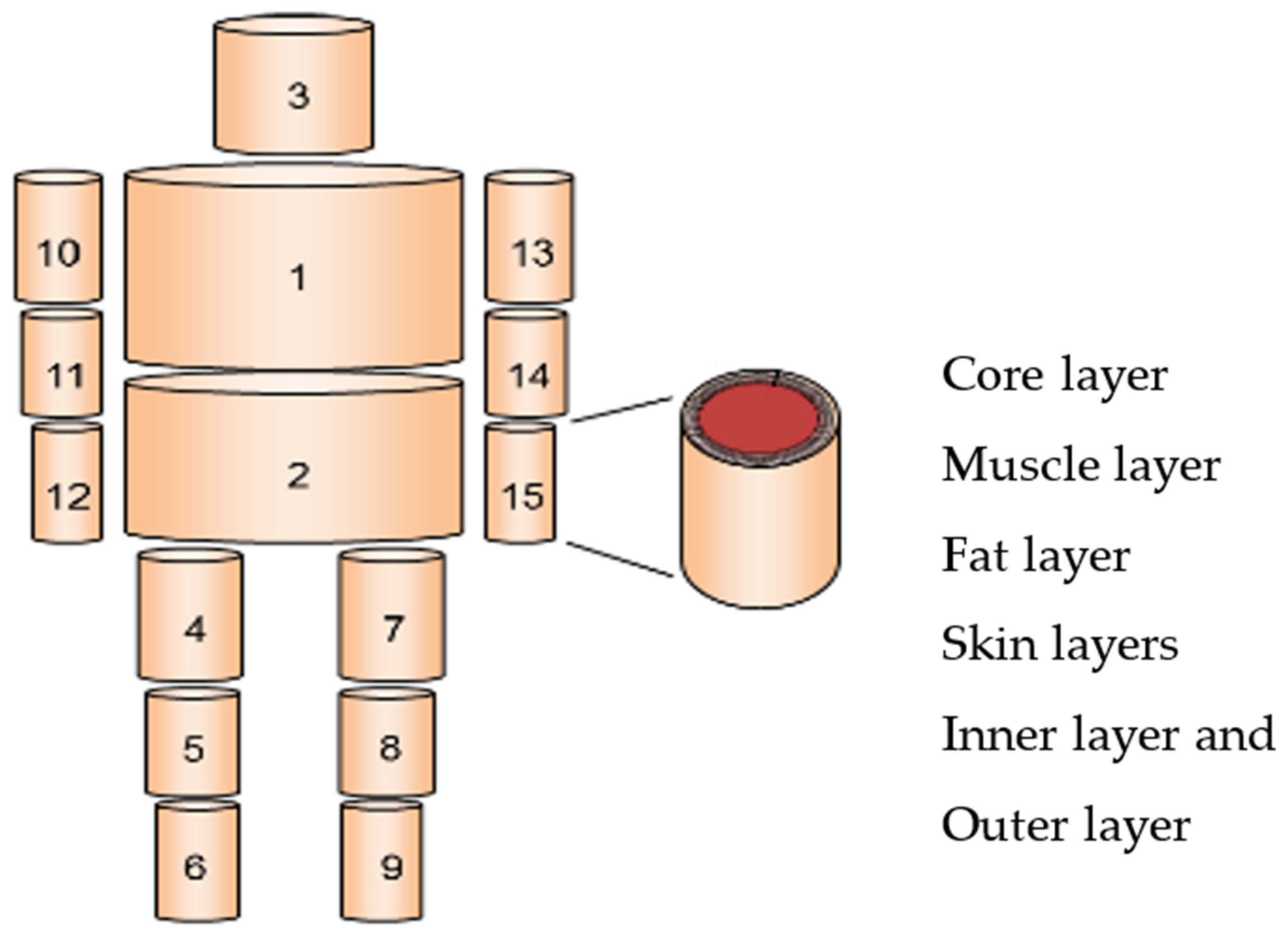
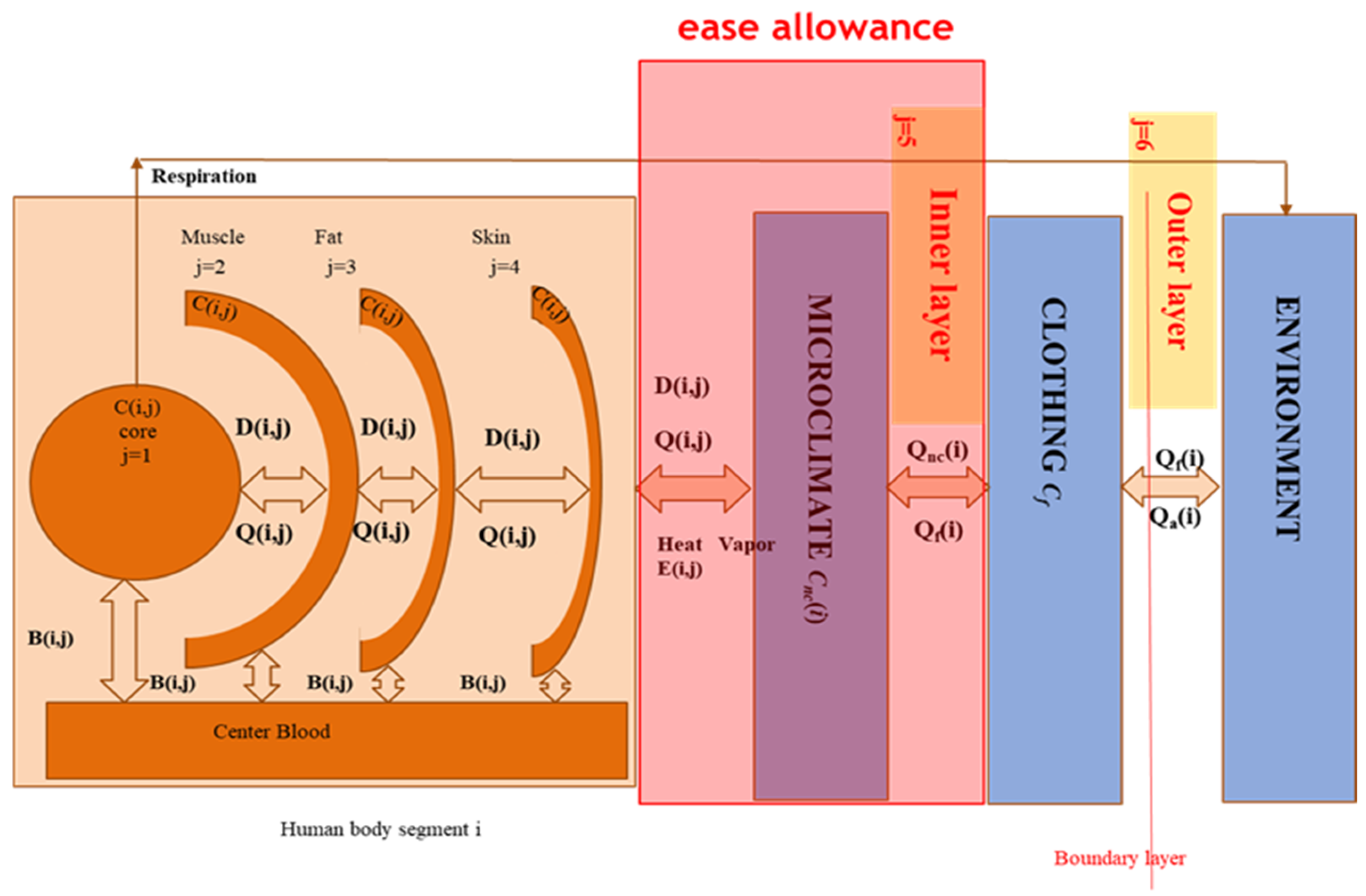
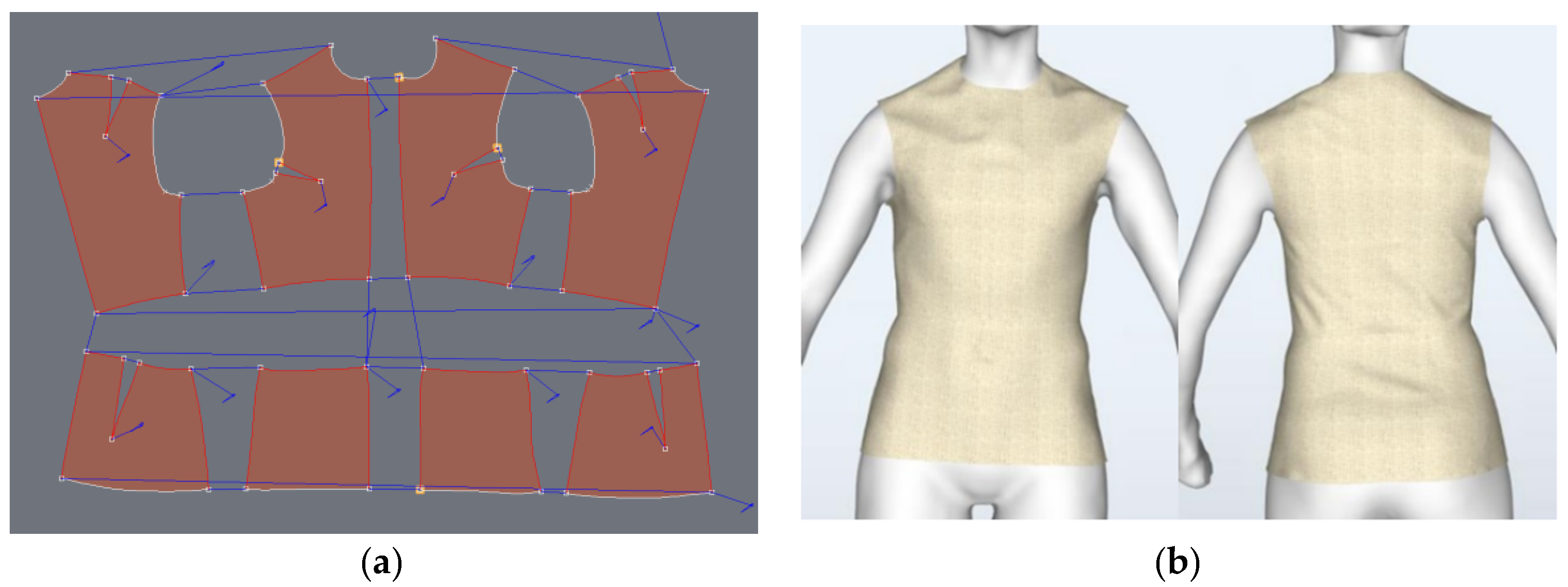

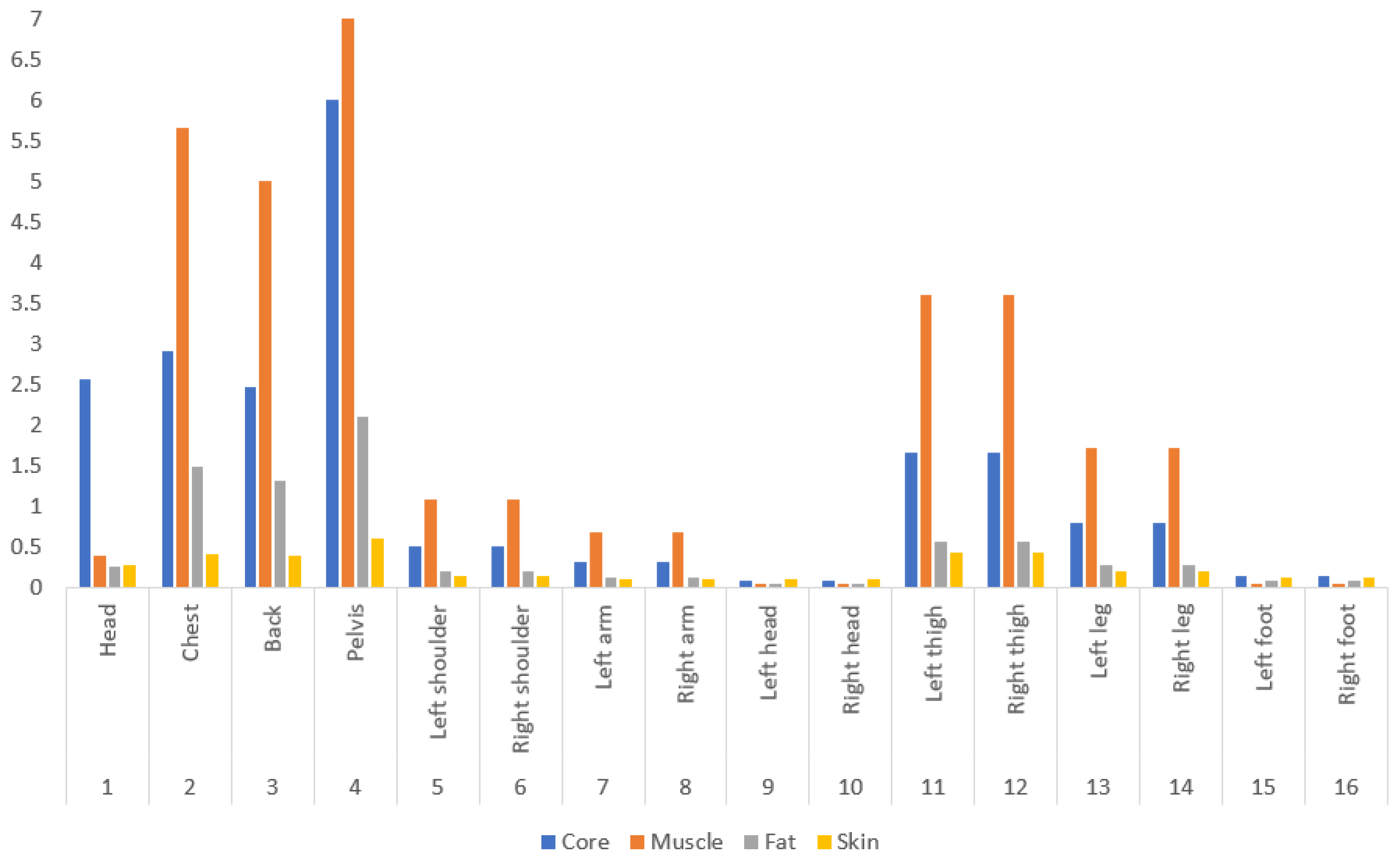
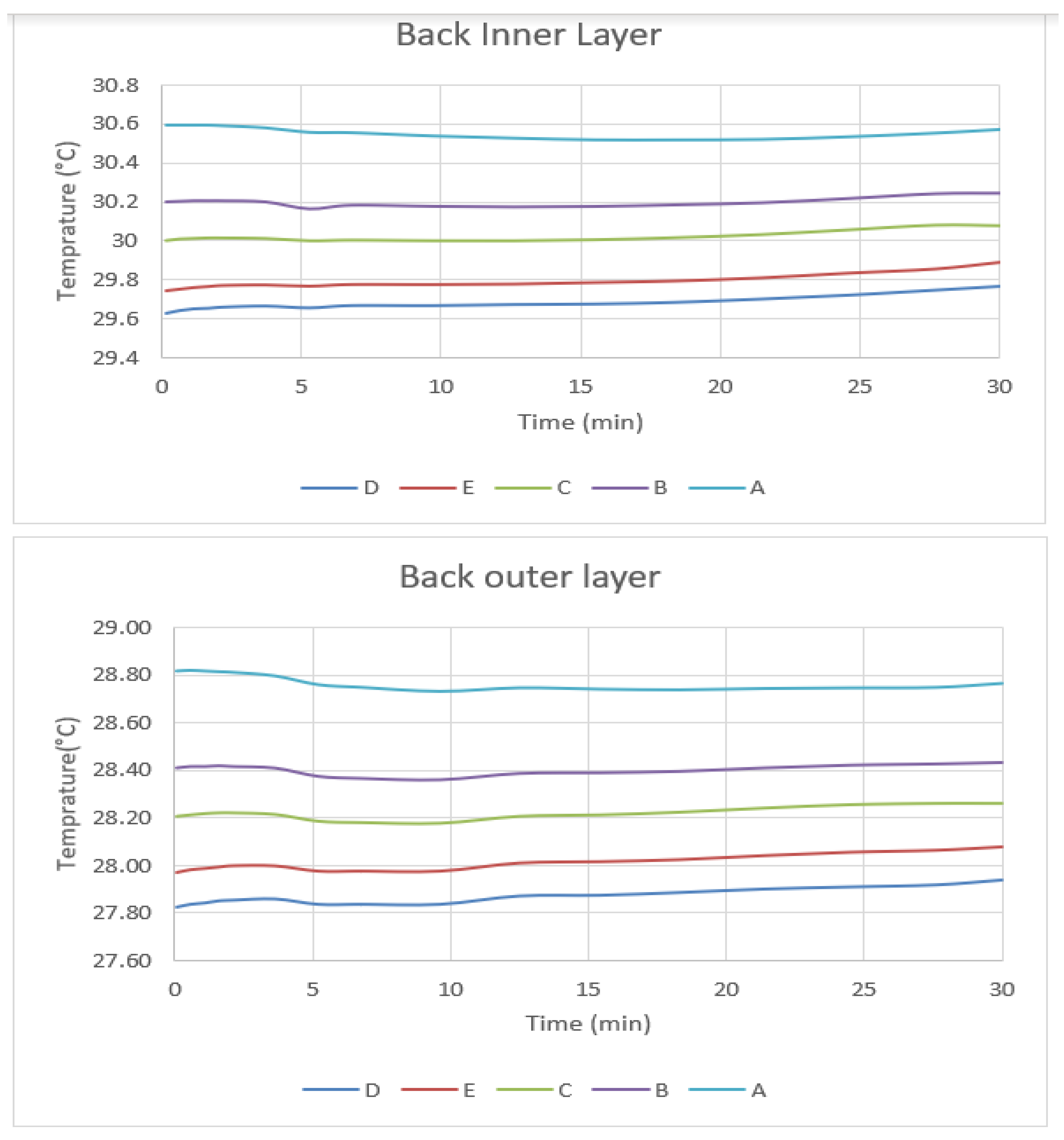


| Garment Code | A | B | C | D | E |
|---|---|---|---|---|---|
| Air gap thickness, cm | 0.5 | 0.8 | 1.15 | 1.55 | 1.95 |
| Fiber Type | Cotton |
|---|---|
| Area density, g/m2 | 126 |
| Thickness, mm | 0.312 |
| Warp density, 1/10 cm | 585.6 |
| Weft density, 1/10 cm | 284 |
| Thermal resistant, clo | 0.155 |
| i | Segment (i) | An(i) (m2) | Acl(i) (m2) |
|---|---|---|---|
| 1 | Head | 0.140 | 0.1400 |
| 2 | Chest | 0.175 | 0.1886 |
| 3 | Back | 0.161 | 0.1735 |
| 4 | Pelvis | 0.221 | 0.2347 |
| 5 | Left shoulder | 0.096 | 0.1020 |
| 6 | Right shoulder | 0.096 | 0.1020 |
| 7 | Left arm | 0.063 | 0.0669 |
| 8 | Right arm | 0.063 | 0.0669 |
| 9 | Left head | 0.050 | 0.0500 |
| 10 | Right head | 0.050 | 0.0500 |
| 11 | Left thigh | 0.209 | 0.2220 |
| 12 | Right thigh | 0.209 | 0.2220 |
| 13 | Left leg | 0.112 | 0.1189 |
| 14 | Right leg | 0.112 | 0.1189 |
| 15 | Left foot | 0.056 | 0.0560 |
| 16 | Right foot | 0.056 | 0.0560 |
| i | Segment (i) | H(i) (m) |
|---|---|---|
| 1 | Head | 0.1894 |
| 2 | Chest | 0.5504 |
| 3 | Back | 0.5023 |
| 4 | Pelvis | 0.2134 |
| 5 | L-shoulder | 0.1750 |
| 6 | R-shoulder | 0.1750 |
| 7 | L-arm | 0.4735 |
| 8 | R-arm | 0.4735 |
| 9 | L-hand | 0.1950 |
| 10 | R-hand | 0.1950 |
| 11 | L-thigh | 0.4490 |
| 12 | R-thigh | 0.4490 |
| 13 | L-leg | 0.4280 |
| 14 | R-leg | 0.4280 |
| 15 | L-foot | 0.2565 |
| 16 | R-foot | 0.2565 |
| i | Segment | Core | Muscle | Fat | Skin | Inner Surface Fabric (A) | Outer Surface Fabric (A) |
|---|---|---|---|---|---|---|---|
| 1 | Head | 36.9 | 36.1 | 35.8 | 35.6 | 35.6 | 35.6 |
| 2 | Chest | 36.5 | 36.2 | 34.5 | 33.6 | 31.5 | 29.2 |
| 3 | Back | 36.5 | 35.8 | 34.4 | 33.2 | 31.5 | 29.2 |
| 4 | Pelvis | 36.3 | 35.6 | 34.5 | 33.4 | 31.4 | 29 |
| 5 | L-Shoulder | 35.8 | 34.6 | 33.8 | 33.4 | 31.4 | 29 |
| 6 | R-Shoulder | 35.8 | 34.6 | 33.8 | 33.4 | 31.4 | 29 |
| 7 | L-arm | 35.5 | 34.8 | 34.7 | 34.6 | 32.5 | 30.5 |
| 8 | R-arm | 35.5 | 34.8 | 34.7 | 34.6 | 32.5 | 30.5 |
| 9 | L-hand | 35.4 | 35.3 | 35.3 | 35.2 | 35.2 | 35.2 |
| 10 | R-hand | 35.4 | 35.3 | 35.3 | 35.2 | 35.2 | 35.2 |
| 11 | L-thigh | 35.8 | 35.2 | 34.4 | 33.8 | 31.8 | 29 |
| 2 | R-thigh | 35.8 | 35.2 | 34.4 | 33.8 | 31.8 | 29 |
| 13 | L-leg | 35.6 | 34.4 | 33.9 | 33.4 | 31.6 | 29.3 |
| 14 | R-leg | 35.6 | 34.4 | 33.9 | 33.4 | 31.6 | 29.3 |
| 15 | L-foot | 35.1 | 34.9 | 34.4 | 33.9 | 33.9 | 33.9 |
| 16 | R-foot | 35.1 | 36.7 | 34.4 | 33.9 | 33.9 | 33.9 |
Publisher’s Note: MDPI stays neutral with regard to jurisdictional claims in published maps and institutional affiliations. |
© 2021 by the authors. Licensee MDPI, Basel, Switzerland. This article is an open access article distributed under the terms and conditions of the Creative Commons Attribution (CC BY) license (https://creativecommons.org/licenses/by/4.0/).
Share and Cite
Mosleh, S.; Abtew, M.A.; Bruniaux, P.; Tartare, G.; Loghin, E.-C.; Dulgheriu, I. Modeling and Simulation of Human Body Heat Transfer System Based on Air Space Values in 3D Clothing Model. Materials 2021, 14, 6675. https://doi.org/10.3390/ma14216675
Mosleh S, Abtew MA, Bruniaux P, Tartare G, Loghin E-C, Dulgheriu I. Modeling and Simulation of Human Body Heat Transfer System Based on Air Space Values in 3D Clothing Model. Materials. 2021; 14(21):6675. https://doi.org/10.3390/ma14216675
Chicago/Turabian StyleMosleh, Sara, Mulat Alubel Abtew, Pascal Bruniaux, Guillaume Tartare, Emil-Constantin Loghin, and Ionut Dulgheriu. 2021. "Modeling and Simulation of Human Body Heat Transfer System Based on Air Space Values in 3D Clothing Model" Materials 14, no. 21: 6675. https://doi.org/10.3390/ma14216675
APA StyleMosleh, S., Abtew, M. A., Bruniaux, P., Tartare, G., Loghin, E.-C., & Dulgheriu, I. (2021). Modeling and Simulation of Human Body Heat Transfer System Based on Air Space Values in 3D Clothing Model. Materials, 14(21), 6675. https://doi.org/10.3390/ma14216675







